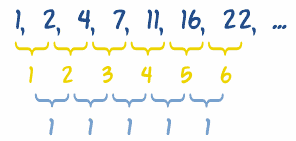BACK
Definition of Sequence
A Sequence is a set of things (usually numbers) that are in order.
Each number in the sequence is called a term (or sometimes "element" or "member"): |
Finding Missing Numbers
To find a missing number, first find a Rule behind the Sequence.Sometimes we can just look at the numbers and see a pattern:
Example: 1, 4, 9, 16, ?
Answer: they are Squares (12=1, 22=4, 32=9, 42=16, ...)Rule: xn = n2
Sequence: 1, 4, 9, 16, 25, 36, 49, ...
Did you see how we wrote that rule using "x" and "n" ?
xn means "term number n", so term 3 is written x3
And we also used "n" in the formula, so the formula for term 3 is 32 = 9. This could be written
x3 = 32 = 9
Once we have a Rule we can use it to find any term. For example, the 25th term can be found by "plugging in" 25 wherever n is.
x25 = 252 = 625
How about another example:
Example: 3, 5, 8, 13, 21, ?
After 3 and 5 all the rest are the sum of the two numbers before, that is 3 + 5 = 8, 5 + 8 = 13 and so on (it is actually part of the Fibonacci Sequence):
Rule: xn = xn-1 + xn-2
Sequence: 3, 5, 8, 13, 21, 34, 55, 89, ...
Now what does xn-1 mean? It just means "the previous term" because the term number (n) is 1 less (n-1).
So, if n was 6, then xn = x6 (the 6th term) and xn-1 = x6-1 = x5 (the 5th term)
So, let's apply that Rule to the 6th term:
x6 = x6-1 + x6-2
x6 = x5 + x4
We already know the 4th term is 13, and the 5th is 21, so the answer is:
x6 = 21 + 13 = 34
Pretty simple ... just put numbers instead of "n"
Many Rules
One of the troubles with finding "the next number" in a sequence is that mathematics is so powerful we can find more than one Rule that works.What is the next number in the sequence 1, 2, 4, 7, ?
Here are three solutions (there can be more!):
Solution 1: Add 1, then add 2, 3, 4, ...
So, 1+1=2, 2+2=4, 4+3=7, 7+4=11, etc...
Rule: xn = n(n-1)/2 + 1
Sequence: 1, 2, 4, 7, 11, 16, 22, ...
(That rule looks a bit complicated, but it works)
Solution 2: After 1 and 2, add the two previous numbers, plus 1:
Sequence: 1, 2, 4, 7, 12, 20, 33, ...
Solution 3: After 1, 2 and 4, add the three previous numbers
Sequence: 1, 2, 4, 7, 13, 24, 44, ...
Simplest Rule
When in doubt choose the simplest rule that makes sense, but also mention that there are other solutions.Finding Differences
Sometimes it helps to find the differences between each pair of numbers ... this can often reveal an underlying pattern.Here is a simple case:

The differences are always 2, so we can guess that "2n" is part of the answer.
Let us try 2n:
| n: | 1 | 2 | 3 | 4 | 5 |
|---|---|---|---|---|---|
| Terms (xn): | 7 | 9 | 11 | 13 | 15 |
| 2n: | 2 | 4 | 6 | 8 | 10 |
| Wrong by: | 5 | 5 | 5 | 5 | 5 |
The last row shows that we are always wrong by 5, so just add 5 and we are done:
Rule: xn = 2n + 5
OK, we could have worked out "2n+5" by just playing around with the numbers a bit, but we want a systematic way to do it, for when the sequences get more complicated.
Second Differences
In the sequence {1, 2, 4, 7, 11, 16, 22, ...} we need to find the difference and then find the differences of those (called second differences), like this:
The second differences in this case are 1.
With second differences we multiply by "n2 / 2".
In our case the difference is 1, so let us try n2 / 2:
| n: | 1 | 2 | 3 | 4 | 5 |
|---|---|---|---|---|---|
| Terms (xn): | 1 | 2 | 4 | 7 | 11 |
| n2: | 1 | 4 | 9 | 16 | 25 |
| n2 / 2: | 0.5 | 2 | 4.5 | 8 | 12.5 |
| Wrong by: | 0.5 | 0 | -0.5 | -1 | -1.5 |
We are close, but seem to be drifting by 0.5, so let us try: n2 / 2 - n/2
| n2 / 2 - n/2: | 0 | 1 | 3 | 6 | 10 |
|---|---|---|---|---|---|
| Wrong by: | 1 | 1 | 1 | 1 | 1 |
Wrong by 1 now, so let us add 1:
| n2 / 2 - n/2 + 1: | 1 | 2 | 4 | 7 | 11 |
|---|---|---|---|---|---|
| Wrong by: | 0 | 0 | 0 | 0 | 0 |
The formula n2 / 2 - n/2 + 1 can be simplified to n(n-1)/2 + 1
So by "trial-and-error" we discovered a rule that works:
Rule: xn = n(n-1)/2 + 1
Sequence: 1, 2, 4, 7, 11, 16, 22, 29, 37, ...
No comments:
Post a Comment